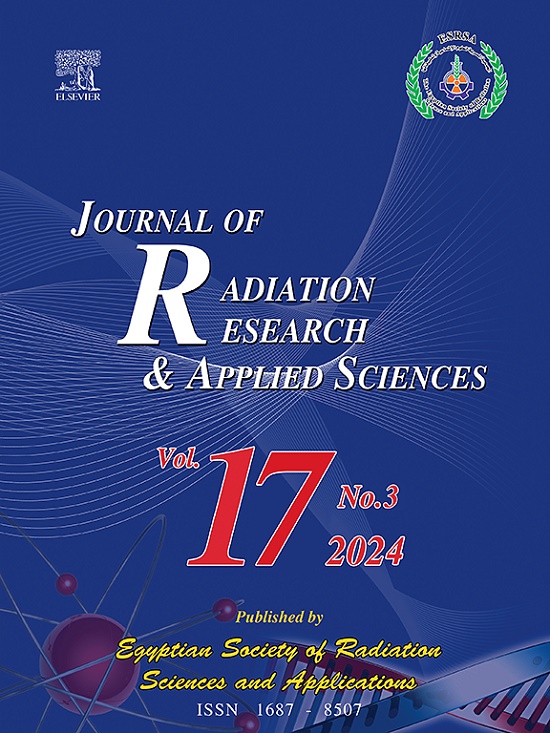Shape features in magnetized hybrid nanofluid subject to thermal radiation, viscous dissipation and chemical effects: Insight to nanoparticles morphology
IF 1.7
4区 综合性期刊
Q2 MULTIDISCIPLINARY SCIENCES
Journal of Radiation Research and Applied Sciences
Pub Date : 2025-05-10
DOI:10.1016/j.jrras.2025.101574
引用次数: 0
Abstract
The hybrid nanomaterials are advanced working fluids that offer enhanced thermal impact due to combination of multiple nanoparticles. Owing to improved thermal features, the hybrid nanofluids are assumed to be ideal for enhancing the heat transfer phenomenon in various thermal systems, solar energy, cooling processes, heat exchangers and nuclear systems. Current study explores the thermal management of magnetized hybrid nanofluid with applications of non-classical Fourier approach. A uniform decomposition of titanium dioxide (TiO2) and silicon dioxide (SiO2) nanoparticles with human blood base fluid has been assumed. The improvement of heat transfer is further analyzed by contributing the nonlinear thermal radiation and viscous dissipation effects. The concentration of nanofluid with applications of chemical reaction features is accounted. The mathematical model is developed by following famous Tiwari and Das model. The flow is subject to porous stretched surface subject to realistic engineering, industrial and biomedical engineering. The dimensionless form of problem is retained with implication of scaling parameters. The resultant system is solved numerically via the shooting method coupled with the Runge-Kutta technique, ensuring high accuracy and computational efficiency. Physical insight of key parameters has been examined graphically. The results show that consideration of nonlinear thermal radiation as well as viscous dissipation substantially enhances the transport phenomenon. The change in chemical reaction parameter reduces the concentration phenomenon. Furthermore, the combined impact of magnetohydrodynamics (MHD) and surface permeability alter the flow dynamics, offering valuable insights for optimizing processes in advanced thermal management systems and petroleum engineering.
受热辐射、粘性耗散和化学效应影响的磁化混合纳米流体的形状特征:对纳米颗粒形态的洞察
混合纳米材料是一种先进的工作流体,由于多种纳米颗粒的结合,可以提供增强的热冲击。由于改进的热特性,混合纳米流体被认为是增强各种热系统,太阳能,冷却过程,热交换器和核系统中的传热现象的理想选择。应用非经典傅里叶方法研究磁化混合纳米流体的热管理问题。假设二氧化钛(TiO2)和二氧化硅(SiO2)纳米颗粒与人体血液基液均匀分解。进一步分析了非线性热辐射和粘性耗散效应对传热的改善作用。论述了纳米流体浓度与化学反应特性的应用。数学模型是根据著名的Tiwari和Das模型发展起来的。流动受限于多孔拉伸表面受限于现实工程、工业和生物医学工程。保留了问题的无量纲形式,并隐含了尺度参数。采用射击法结合龙格-库塔法对所得系统进行了数值求解,保证了较高的精度和计算效率。物理洞察力的关键参数已检查图形。结果表明,考虑了非线性热辐射和粘性耗散后,输运现象明显增强。化学反应参数的改变减少了浓度现象。此外,磁流体动力学(MHD)和表面渗透率的综合影响改变了流体动力学,为优化先进热管理系统和石油工程的过程提供了有价值的见解。
本文章由计算机程序翻译,如有差异,请以英文原文为准。
求助全文
约1分钟内获得全文
求助全文
来源期刊

Journal of Radiation Research and Applied Sciences
MULTIDISCIPLINARY SCIENCES-
自引率
5.90%
发文量
130
审稿时长
16 weeks
期刊介绍:
Journal of Radiation Research and Applied Sciences provides a high quality medium for the publication of substantial, original and scientific and technological papers on the development and applications of nuclear, radiation and isotopes in biology, medicine, drugs, biochemistry, microbiology, agriculture, entomology, food technology, chemistry, physics, solid states, engineering, environmental and applied sciences.
 求助内容:
求助内容: 应助结果提醒方式:
应助结果提醒方式:


